Jonathan and Crystal discuss 10 horror games that offer lessons for haunters.
Hello, it’s Jonathan and Crystal again. This blog is based on Episode 185 of Haunt Weekly, which was titled, “10 Horror Games for Haunters.” This isn’t a top-10 list of great horror games or anything like that, but 10 games that, if you’re a haunter, you might want to play because you might learn something.
We’ve talked about video games on this show multiple times. In Episode 22, we talked about the topic more broadly and didn’t really list specific games. In Episode 109, we spent the entire show talking about Layers of Fear. That game had a sequel come out recently, and it appears to be similar to the original, so I’m stoked. I’ve not played it yet, so no spoilers. Go back and check those two episodes out, especially the Layers of Fear episode, because that was a really good talk about aphantasia [which refers to the inability to voluntary visualize imagery] in haunting.
We haven’t played all of the 10 games we’re going to talk about, so we can only speak to videos we’ve seen and other things we know about them. Also, we’re not saying every one of these games is good. In fact, we’ll mention a couple of games I didn’t think were very good but have interesting lessons for haunters. The point of including these videos is that they have something that haunters can learn from. Oh, we’re also mentioning Layers of Fear again. You should play that one if you’re a haunter, so you can learn more about confusion and what aphantasia is like.
Game One: Amnesia—The Dark Descent

The reason for including this is obvious. Amnesia is basically a haunted house with escape-room elements. There’s no combat to speak of. There’s linear-ish movement with free-roaming puzzles to solve.
“I got stuck at the beginning, because I found a different solution to the puzzle that wasn’t a solution at all,” said Crystal.
The game has a cool dynamic of light versus dark, where you have to stay in the dark to stay alive and hide from the monsters and so forth, but you have to be in the light to prevent yourself from going insane. The game really excels in atmosphere—it’s essentially all about the atmosphere. However, if you pay attention as you go through, it’s a minimalist atmosphere in many ways. It’s got stuff to see and do, but it’s not a game that obsesses over every detail. You’ll find a bookshelf, but not every book will have a title on it—things like that. Oftentimes, the terror is more implied than direct. You see a dark hallway, you know something could be in there, but you don’t know what. All in all, it’s a great study in pacing and how to use your atmosphere. It really illustrates how you can do a lot with lighting alone, which is one of the things I think about. We always talk about how haunted attractions need to focus more on their lighting and less on making every detail plum perfect.
Crystal added, “You want to detail anything that will be well-lit, but the rest of it, nobody is going to notice.”
Amnesia is a very good game. I really enjoyed it.
Game Two: Five Nights at Freddy’s
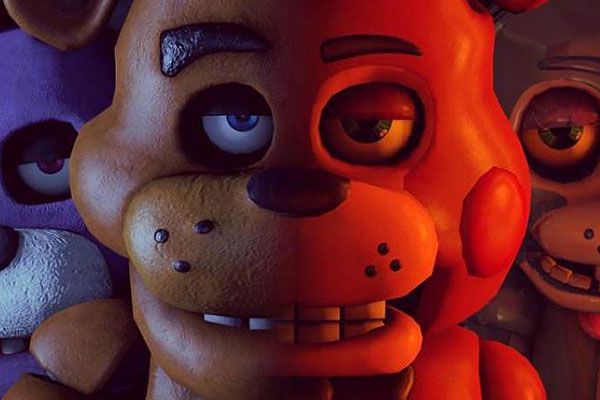
OK, I know you’re rolling your eyes. Five Nights at Freddy’s? That’s all millennial BS and nyah nyah nyah.
“That’s kid’s stuff and all that,” said Crystal.
Hear me out on this, because I have a theory here. Long story short, the one thing Five Nights at Freddy’s does—other than overstay it’s welcome, because it’s on its 25th game or something like that—is make the mundane and childish genuinely creepy and scary. Go back to the first one or two, and you’ll see what I mean. It’s like, “OK, it’s easy to make the Chuck E Cheese animatronics look creepy if you put them in the dark.” Study those character models, look at how they carve the eyes, look at the faces and the smiles they have. Look at the actual way they’re designed, and you quickly see—especially when you compare it to Chuck E Cheese animatronics—they’ve made these more sinister, but very, very stealthily. It’s a subtle thing, but it works extremely well. It’s really effective in terms of making something that ordinarily might be creepy or unsettling genuinely terrifying.
“Right, and there’s the whole game mechanic of how much battery do you have left to watch the cameras. It’s a great way to build tension, too.”
I like the aesthetics, but I didn’t like the gameplay. The gameplay just wasn’t for me. However, I can see why a lot of people find this good horror.
Game Three: Condemned Criminal Origins
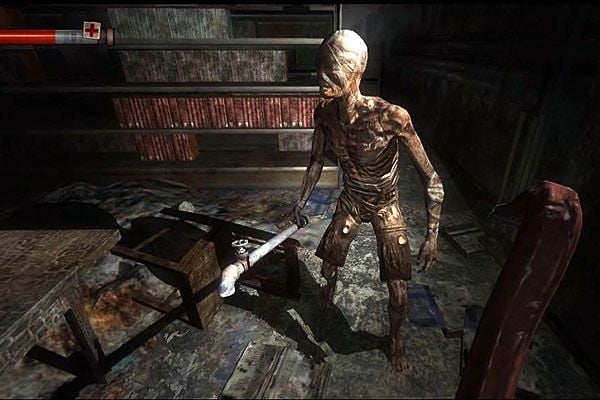
This may be the first one on the list that even fairly avid gamers might not have played. They might have heard of it but might not have played. This game came out, and no one really did anything with it. It didn’t get a lot of attention. That’s a shame, because Condemned is basically a first-person “shooter,” but it’s not really a shooter, because you go through the entire game only getting the gun once, it only has six bullets, and, when it’s empty, you’re done. That’s because it’s entirely melee-based. The game has you doing things like ripping pipes from the wall to bash people with. Ever since I played this game, whenever I look at a pipe, I have to resist the urge to grip it, grab it, and beat some drug addict that’s attacking me.
“There are no drug addicts in it,” noted Crystal.
No, there aren’t. Anyway, give this game a play, because I like how it manages to make the violence feel visceral and personal without using a lot of blood. That’s something I think a lot of haunts don’t understand. They have the idea that to make violence feel “real,” they have to have blood spurting everywhere, and you don’t.
“Imagine if you did one of the laser-tag games but you only had a limited number of bullets.”
That’s attention on the ammo, there.
“Exactly.”
Game Four: Dead Space
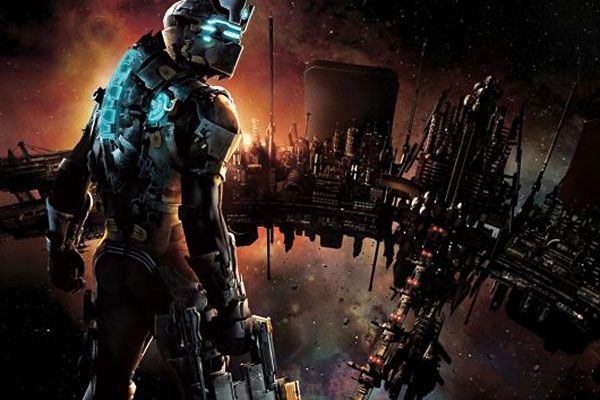
Regarding Dead Space, just focus on the first two. I haven’t played the third, and, apparently, I should keep it that way. That’s what I’ve heard. I enjoyed Dead Space, but when I was finished, I thought, “It was pretty good, had some good jump scares, some good moments, blah, blah, blah. It was adequate.” Then I naffed off. I happened to start watching this YouTube series called War Stories, and it was about game developers talking about the challenges they had to overcome making video games. There was a video about the original Dead Space. One thing they talked about was all the play-testing they did to try to figure out how people respond to different things: “OK, we have an alien come through a vent here. Where do they go, what do they do? When the alien comes through the vent, most people get the gun and slide backwards. What if we had something else spawn right behind them and not have it immediately attack them but do the ‘Aaarrgghh!’ right in their ear?”
“Exactly. If you have a room that’s got a big pop in the line of sight, and your customer startles and steps backward, you could have somebody waiting right behind them,” said Crystal
Game Five: Slender: The Eight Pages
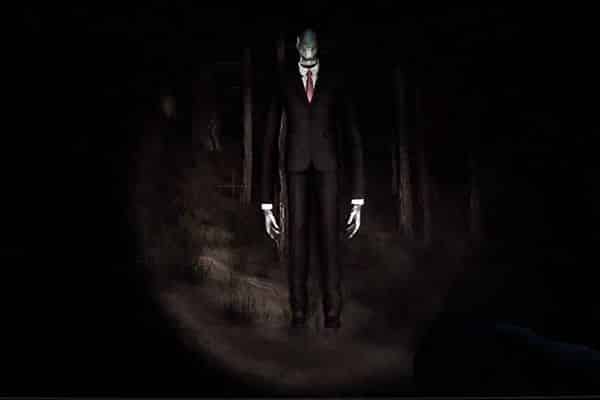
I’ve not played the commercial release sequel, even though it’s gotten good reviews and people say good things. But, man, have we played Slender: The Eight Pages. When Hurricane Isaac hit many years ago here in New Orleans, we knew we’d be fine in the city, even though the power was going to be out for an extended period of time. We downloaded this came to my laptop and, when the power went out, the city was totally dark, and the storm was still raging outside, we played Slender: The Eight Pages, but badly.
“Yes!”
Horribly badly. It was more like Slender, the 3-1/2 pages the way we were playing it. We weren’t good at it. Long story short, this is a freeware game, so there’s no reason not to pick this one up. Also, the play cycle on it is only a few minutes long. However, it’s a very interesting study in what you can do with very little. Don’t go expecting high-budget graphics or anything, although it looks pretty good. It’s simple, effective, and the game developers made a lot of smart decisions. For example, the tension builds very slowly. When you go to find your first page, everything is pretty clear. Slenderman is pretty far away.
Game Six: Silent Hill
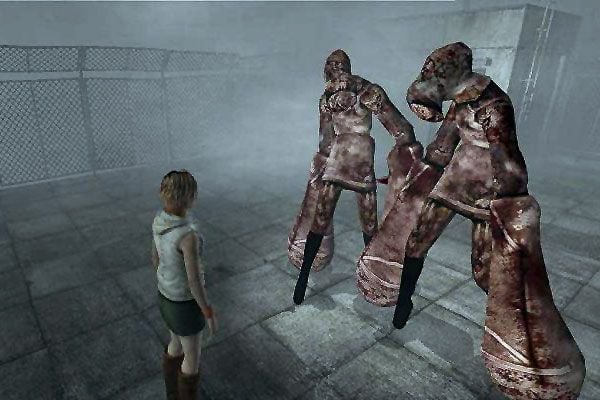
I recommend, in particular, number two but also number one. This is another classic, but it’s one that many people get the wrong lessons from, to my mind. People think it’s all about these super-scary monsters, but really, to me at least, what creates the best tension is the fog that’s used to create constant disorientation. What I found particularly unnerving (and other people have said this, too), is the Uncanny Valley. In particular, the nurses. They don’t have to tell you the story about what’s wrong, because you know something is wrong instinctively. That’s what’s so powerful about it for haunters. You could have a character like this in a room in a haunt, and everyone is going to know something is messed up. Nobody is going to ask too many questions about it. “That person isn’t right, and I’m deeply unsettled by them.” Also, this is great for getting attention so you can do a scare. Characters like this are a great distraction, because people are disturbed by them, but they can’t look away from them either.
Game Seven: F.E.A.R.
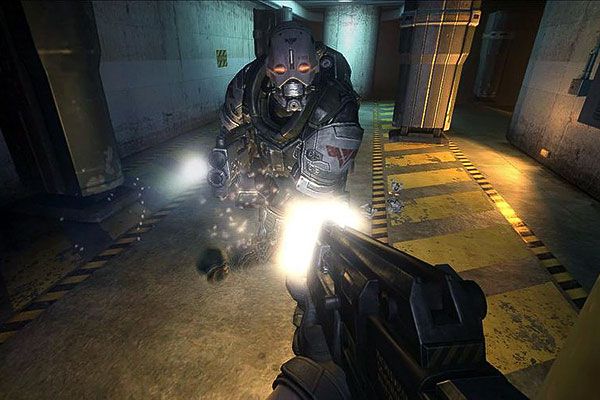
I mostly recommend the first and second F.E.A.R., but I feel kind of weird including F.E.A.R. Even though it advertises itself as a horror game, I don’t think of it as one. The reason is because, to me, it’s more of an action shooter. However, I feel it belongs on this list because you’re this badass who can lawful stomp nearly everything on the map, but it still manages to be scary. That’s one of the dynamics that people don’t understand. One of the reasons why horror shooters don’t often work is because, if I’m the scariest thing in the room, you’re not going to make me afraid. If I’m the baddest guy in the bar, I’m not scared of a fight. You know what I mean? Most shooters, by design, make you the baddest person in the game. You’re taking out hundreds and hundreds of bad guys without batting an eyelash, and you’re soaking up bullet damage like it’s nothing. That’s what these games are. If you’re the baddest person on the planet, there’s not much you should be scared of. What this game does is it has an antagonist that’s significantly more powerful than you are—and can bend reality. That’s the main thing.
“Exactly. I think some of those scenes where reality is bent can be done by changing the lighting in a haunt,” offered Crystal. “There’s a hospital scene where you’re going down the hallway, and it looks like a regular hallway, and then the entire feel of the room changes. Basically, it’s just a lighting change.”
Game Eight: Fatal Frame
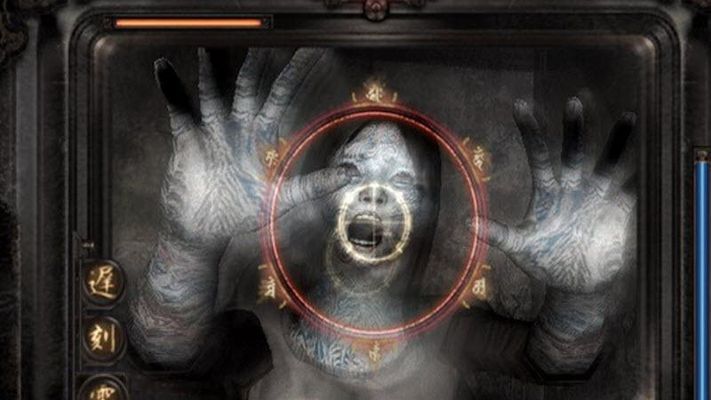
We’ve not played this one. Everything I’ve read says go with number two as the best one, but here’s the thing that’s interesting: The enemies are everywhere around you in this game, but they’re ghosts. You can’t see them, you can’t chase them, and you can’t hurt them. You have what’s known as a Camera Obscura, which helps you see, track, and fight these ghosts, but you’re limited in using it. The game uses this mechanic to tell a complicated narrative in the universe. Something like this could theoretically be brought in for AR stuff but maybe not so much in haunted attractions. I don’t think we want people holding up their iPhones going through a haunted house. There are ways you can add AR elements like this that would be interesting and compelling but also kind of scary and unsettling. I think haunts have gotten interested in virtual reality, especially virtual reality arcades, but haven’t explored augmented reality much.
“I think a lot of that is just because it’s new,” said Crystal.
It is new, but it’s always kind of weird to me, the technology that haunted attractions scoop up right away. Like, when Arduino came out, haunted attractions were probably the biggest buyers of that outside of Silicon Valley.
“I agree with that.”
Game Nine: Manhunt
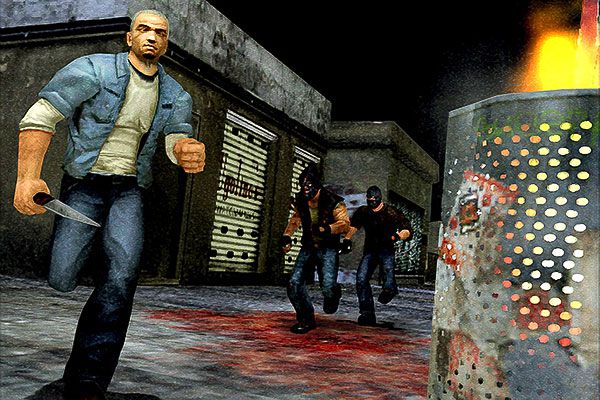
The history of Manhunt is pretty well known to most gamers. It was a 2003 game that was so controversial it was actually banned in many countries because of the extreme violence. Think of the Running Man movie but with graphic, ultraviolent kills. It’s like you’re trying to please a sinister director by making the kills more violent, more gory, and more horrific.
The game sure as hell features a lot of the ultraviolence. Every time I got a new weapon, it was cool to see what kind of new kills you could do with it, but the mechanic got old. That hardcore, ultra-gory, ultra-gritty violence didn’t hold my attention. It’s an interesting case study in how hot-shotting violence and gore gets old. If every room in your haunt is super-duper gory and messed up, it loses its impact. The same thing is true for anything if you do it in every room.
“I do like the idea of the overseer from this game being brought into an escape room,” said Crystal.
That would be awesome.
“Someone who’s intentionally not going to help you.”
Or is only helping you to their own selfish ends.
“Or, have two of them—one who’s a helper and one who isn’t, and play them off of each other.”
Game 10: Dead Island

I did play this one, and I didn’t like it. I didn’t make a lot of progress. Even though there was a lot to love about it, the game mechanics and the combat, in particular, were frustrating. I just couldn’t get into it. It was too much of a struggle to play the game, if that makes any sense. The game was good, but it was a war to play it.
Here’s the thing. It’s a zombie apocalypse set on a tropical resort. It’s not really played for comedy, but you can think of a lot of easy jokes here. I’m pretty sure I can, but it’s a serious horror setting, and it works. You might think it isn’t disturbing when a bunch of zombies come into a tiki bar to get you, but it can be. What I liked about this game, even though it failed mechanically in other areas, is it at least attempted to explore a much different horror setting than we typically see. Other games, like Dead Rising, have done shopping malls, but then again, we’ve seen plenty of movies with that, too. Dead Island has a very, very unusual setting in that it isn’t a laboratory, it isn’t a castle, and it isn’t a dungeon. It’s a beautiful, sunny, tropical island, and it still works as a horror setting.
“How about putting the zombies from this into the Kid’s Emporium from Five Nights at Freddy’s?” Crystal suggested.
On that note, we’ll wrap up this blog about horror video games that might be helpful or inspirational for haunters.